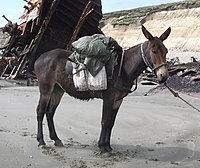
Photo from wikipedia
Native plant materials (NPMs) are increasingly utilized during the restoration of disturbed plant communities. Here, we analyze next‐generation genetic sequencing data for Hilaria jamesii, a dominant graminoid across drylands of… Click to show full abstract
Native plant materials (NPMs) are increasingly utilized during the restoration of disturbed plant communities. Here, we analyze next‐generation genetic sequencing data for Hilaria jamesii, a dominant graminoid across drylands of the southwestern United States, and document that the species' only commercially‐available NPM, “Viva,” is a hybrid between H. jamesii and its sister species, Hilaria mutica. In fact, hybrids between these species are common where they geographically overlap. Furthermore, we show that the “Viva” hybrid has successfully been moved beyond the hybrid zone and into the core range of H. jamesii. The potential ramifications of introducing novel genetic material into H. jamesii are discussed, as well as the utility of genetic analyses to protect species' natural patterns of genetic diversity and help managers make informed decisions regarding the development and deployment of NPMs.
Journal Title: Restoration Ecology
Year Published: 2020
Link to full text (if available)
Share on Social Media: Sign Up to like & get
recommendations!